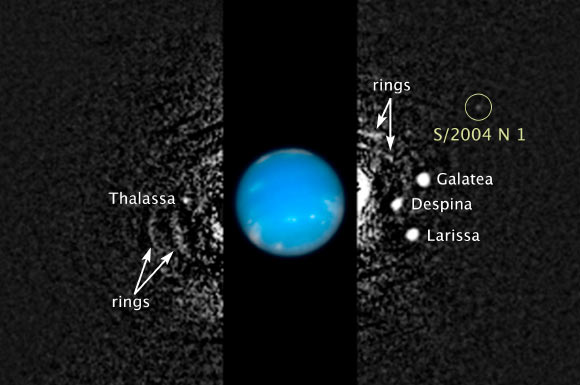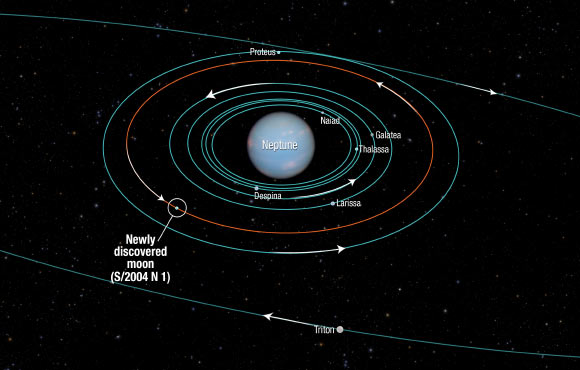Dr Mark Showalter from the SETI Institute in Mountain View, California, has discovered a new moon circling Neptune, the eighth and farthest planet from the Sun in our Solar System.

This image shows the location of the newly discovered Neptune’s moon S/2004 N 1 (NASA / ESA / M. Showalter / SETI Institute)
The moon, labeled S/2004 N 1, is no more than 12 miles (19.3 km) across. It is the smallest known moon in the Neptunian system.
Dr Showalter found S/2004 N 1 on July 1, 2013, while studying the faint ring-arcs of Neptune. The moon is located between the orbits of the Neptunian moons Larissa and Proteus.
“The moons and arcs orbit very quickly, so we had to devise a way to follow their motion in order to bring out the details of the system,” he explained.
“It’s the same reason a sports photographer tracks a running athlete – the athlete stays in focus, but the background blurs.”
Dr Showalter extended his analysis outward to regions well beyond the ring system, and noticed an extra white dot about 65,400 miles from the planet.

This image shows the orbits of Neptune’s moons located close to the planet (NASA / ESA / A. Field / STScI)
He next analyzed over a hundred of archival Hubble photographs of Neptune. The same object appeared over and over again. The scientist then plotted a circular orbit for the moon, which completes one revolution around Neptune every 23 hours.
S/2004 N 1 is so dim that it is roughly one hundred million times fainter than the faintest star that can be seen with the naked eye.
According to astronomers, Triton – Neptune’s largest moon – may be a captured icy dwarf planet from the Kuiper Belt at the outer rim of our Solar system. This capture would have gravitationally torn up any original satellite system Neptune possessed. Many of the moons now seen orbiting the planet probably formed after Triton settled into its unusual retrograde orbit about Neptune.
The discovery brings the total number of known moons around Neptune to 14.







